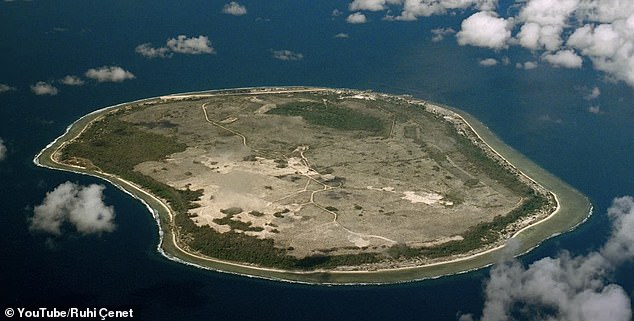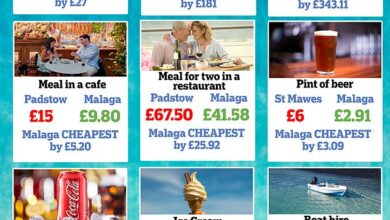I visited the ‘most obese country in the world’ – where people love spam and a police officer was ‘too fat to fit in his Lamborghini’

A fascinating documentary takes viewers to one of the world’s least-visited countries, where obesity and cigarette addiction are rife.
Ruhi Çenet ventured to the small, oval island of Nauru, which is located over 2,900 kilometers northeast of Australia.
In a YouTube video describing his journey, Ruhi discovers that the 20.5-square-kilometer rock formation receives only “one or two tourists” a month.
Part of the problem is the remoteness of the country. The only way to reach Nauru is by plane, because the coral reefs surrounding the island make it impossible for ships to dock.
Ruhi traveled for nearly 48 hours to get there, with a 13.5-hour flight from Istanbul to San Francisco, followed by a seven-hour layover. He then took a 13-hour flight to Nadi in the Fiji Islands, with another seven-hour layover.

A fascinating documentary takes viewers to one of the world’s least-visited countries, where obesity and cigarette addiction are rife
The last party of the trip takes a four-hour flight from Fiji to the small, single-runway airport on Nauru.
He said 75 percent of the seats on this leg of the journey were unoccupied.
In his documentary, Ruhi explains that Nauru was once one of the richest islands per capita, thanks to revenues from phosphate mining and a small population.
An article in The New York Times from 1982, entitled ‘World’s Richest Little Isle’, states that ‘the annual government revenue from the sale of phosphate amounts to at least $123 million, or more than $27,000 a year for every man, woman and child from Nauru.’
People were so wealthy, Ruhi says, that there was a “spending frenzy” and on one part of the island he discovers dozens of supercars from that era, left to rust.
A local resident he meets tells how even the police were in on the money, with one officer buying a Lamborghini before realising he was ‘too fat to fit in it’.
However, as predicted in the New York Times article, Nauru’s major phosphate reserves were depleted and companies found it cheaper to mine elsewhere.
Ruhi points out that due to mining, the land on the island is no longer usable for agriculture and all food has to be imported.

Ruhi Çenet ventured to the small oval island of Nauru, which lies more than 1,800 miles northeast of Australia
According to him, this has contributed to the obesity epidemic in the country.
He explains: ‘In these devastated areas where fruits and vegetables cannot grow, processed and fatty foods have become the norm.
‘Nauru is recognised by the World Obesity Federation as the most obese country in the world, with approximately 60 per cent of the population being obese.’
In one scene, Ruhi goes to a supermarket, where the shelves are mostly filled with canned food.
Spam is said to be one of the most popular products on the island.
Meanwhile, fruit and vegetable prices are sky-high. He can find a cauliflower for AUD$18.59 ($12.45), while a whole watermelon costs AUD$61.13 ($40.95).
Ruhi says Nauru, which gained independence in 1968, not only has an unhealthy diet but also tops the list when it comes to cigarette consumption.
According to the World Health Organisationthe country has the highest smoking rate in the world at 52.1 percent.
It is noted that ‘surprisingly, women in Nauru smoke slightly more than men (52.6 percent versus 51.7 percent), which is somewhat of an outlier.’

Spam is said to be one of the most popular products on the island

Besides an unhealthy diet, Ruhi reveals that Nauru also tops the list when it comes to cigarette consumption
As for the layout of the island, Ruhi notes that there is no official capital, although Yaren is the seat of parliament and some government offices.
It is also home to the country’s only police station, a fire station and an airport.
As he explores the town, he comes across the parliament building. He says the building is very small and has a relaxed atmosphere.
In another part of the YouTube film, Ruhi describes the dark side of the island.
For 20 years, asylum seekers trying to reach Australia by boat were diverted to Nauru. Ruhi says three camps were set up.
He elaborates on the events and continues: ‘Approximately 1,000 refugees, mainly of Afghan, Iraqi and Iranian origin, were transported to Nauru and held indefinitely.
‘People had to live in plastic tents for years, under the scorching sun, without regular access to clean water.
‘Many tried to escape inhumane, miserable conditions and an uncertain future by ending their lives.

As for the layout of the island, Ruhi notes that there is no official capital, although Yaren is the location of the legislature and some government offices

The only way to reach Nauru is by plane, as the coral reefs surrounding the island make it impossible for ships to dock.
‘Those who suffered most from this situation were the children. They formed the majority of the camps.
‘Australia spent an average of $550 million a year on maintaining these camps.
‘In other words, the Nauruan government made a profit of $500,000 for every refugee held on the island.’
During his visit to Nauru, Ruhi tries to visit the refugee camps, but is unable to get in.
He had brought a drone for the trip, but it was confiscated by police at the airport. According to him, the government is very wary of the media investigating life there.
Speaking of scandals, Ruhi also mentions the island’s past as a haven for tax evasion and money laundering.
But he says things have improved since then and the government has revoked the licenses of hundreds of banks registered in the country.
There is now only one bank on the island and the few ATMs rarely have sufficient funds.

So far, Ruhi’s YouTube video has been viewed over 36 million times, with many viewers finding it both ‘educational’ and ‘depressing’.
That’s why he says it’s best to take cash with you to Nauru, where the currency is the Australian dollar.
Ruhi had to spend a total of one week in Nauru exploring the country with the help of a local travel agency, as he had to wait for the next flight home.
At the end of his film he concludes: ‘The illusion of wealth that Nauru suddenly found itself in in the late 1960s left a generation unable to understand the importance of hard work and education.
‘The government has made no plans for the future and has exhausted all the country’s resources.
‘It seems almost impossible to build a better future here without the necessary motivation, skills and knowledge.
‘This little island with wounds that can never heal stands before us as a summary of what is happening in the world and as a lesson that humanity must always remember.’
To date, his YouTube video has been viewed over 36 million times, with many viewers finding the video both “educational” and “depressing.”
One commenter wrote: ‘What a sad story. It’s interesting to note that while they have no worries, the people also seem to have no dreams. The island should be a paradise, but it’s disgusting.’
Another viewer mused: ‘Nauru is unfortunately just a small-scale example of what is happening everywhere on the planet.’




